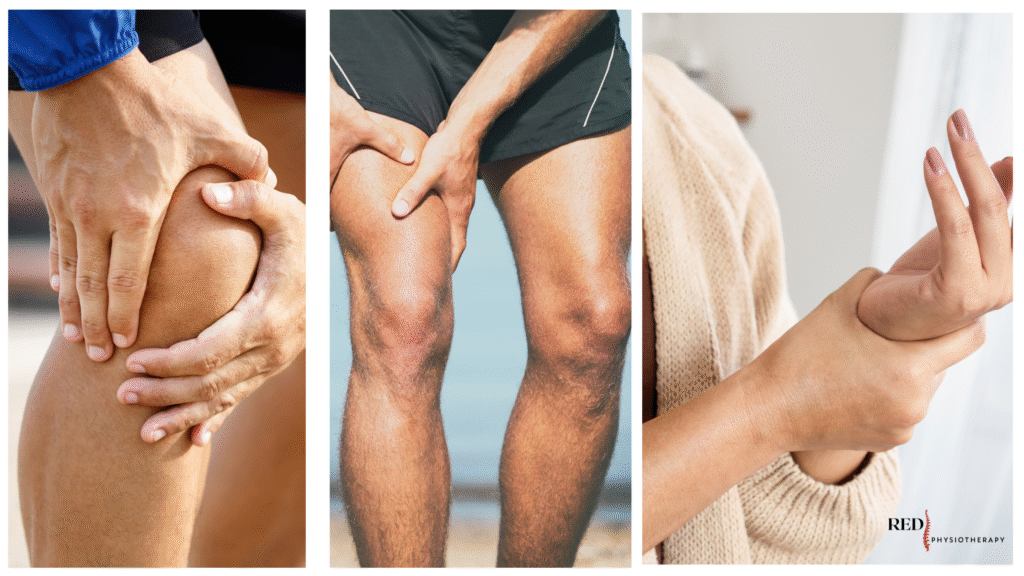
Pain can be confusing. One day it is a dull ache in your shoulder, the next it is a sharp twinge down your leg. It is not always clear where it is coming from or what is causing it. Is it a muscle issue? A joint problem? Or something to do with the nerves?
Understanding the type of pain you are experiencing can help you take the right steps toward recovery. It can also guide you in deciding whether you need rest, targeted exercises, or professional support like physiotherapy. In this blog, we will break down the common characteristics of muscular, joint and nerve-related pain in plain, simple terms.
Muscular Pain: The Classic Ache
Muscle pain is probably the most familiar type. It usually feels like a dull ache or soreness and tends to be more localised. You might notice it after a workout, long day of physical activity, or even from holding a poor posture for too long.
How it feels:
- Achy, stiff or sore
- Often tender to touch
- Worsens with use of the muscle
- Improves with rest and gentle movement
Common signs it is muscular:
- Pain appears after a specific activity or overuse
- It feels better with warmth or massage
- It is spread over a general area, not pinpointed to a joint
- There is no swelling, redness or instability
Examples:
- Shoulder blade soreness from sitting at a desk
- Calf ache after a long walk
- Upper back tightness from poor posture
Muscular pain is often short term and responds well to stretching, rest, massage, and strengthening over time. However, if it lingers or keeps returning, a physio can assess whether weakness or imbalances are contributing.
Joint Pain: Deep, Stubborn and Often Swollen
Joint pain tends to feel deeper and more specific. It can be sharp when you move or weight-bear, and it might feel stiff or locked in the mornings or after inactivity.
How it feels:
- Deep, throbbing or sharp with movement
- Localised around the joint (e.g. knee, hip, shoulder)
- Often worse in the morning or after rest
- Might improve with light activity
Common signs it is joint-related:
- Swelling or warmth around the joint
- Crunching, clicking or popping sensations
- Reduced range of motion
- Feels unstable, like it might “give way”
Examples:
- Knee pain when climbing stairs
- Hip stiffness after sitting
- Shoulder pain when lifting overhead
Joint pain can be due to inflammation, wear and tear (like arthritis), or mechanical issues. While rest can help in the short term, long-term recovery usually involves improving strength, stability and movement patterns around the joint. Physiotherapy is especially useful here, both for assessment and for designing a joint-safe rehab plan.
Nerve Pain: Sharp, Shooting and Unpredictable
How it feels:
- Burning, shooting, stabbing or tingling
- May cause numbness or pins and needles
- Often radiates down a limb (arm or leg)
- Can come and go suddenly or feel constant
Common signs it is nerve-related:
- Pain travels along a specific path (e.g. down the leg)
- Weakness in the limb or grip
- Sensitivity to touch or temperature
- Loss of reflexes or coordination
Examples:
- Sciatic pain running from your lower back to your foot
- Tingling or numbness in fingers due to carpal tunnel
- Burning sensation in the outer thigh (meralgia paraesthetica)
Nerve pain should not be ignored. It often requires a more careful and structured treatment approach. Physiotherapists can assess nerve mobility, tension and root causes, and guide you through exercises that calm the nervous system and restore movement.
Can You Have a Mix of These?
Absolutely. The body is not compartmentalised. A long-standing joint problem can lead to muscle tension. A muscular imbalance might irritate a nearby nerve. It is common to see overlap, which is why a professional assessment is often the best first step when pain is persistent or unclear.
When to See a Physiotherapist
If your pain:
- Has lasted more than a week or two
- Comes back repeatedly
- Is affecting your sleep or daily activities
- Includes nerve symptoms like tingling or numbness
- Changes the way you move or carry yourself
… it is worth having a detailed assessment. Physiotherapists are trained to distinguish between types of pain and tailor treatment accordingly.
You do not need to wait until it is unbearable. The earlier you address it, the easier it is to treat.
What to Expect in an Assessment
At Red Physiotherapy Northampton, we begin with a full discussion of your symptoms when they started, what makes them better or worse, and how they affect your life. Then we assess your movement, strength, joint mobility and nerve function.
Based on what we find, we create a personalised plan that may include:
- Hands-on treatment to reduce pain
- Targeted exercises to improve mobility and strength
- Postural or ergonomic advice
- Techniques to calm nerve irritation
Final Thoughts
Pain can be complicated, but it does not have to be mysterious. Learning to recognise whether your discomfort is muscular, joint or nerve-related is the first step toward feeling better.
No matter the type, most pain can be improved with the right guidance and treatment. And if you are unsure, that is what we are here for.
At Red Physiotherapy, we help people across Northampton understand their pain and take clear steps toward recovery. You do not have to figure it out alone let us help you move forward with confidence.
To book your appointment, call on the number below-
📞 Call 01604 385343 (Northampton) or 01908 713973 (Milton Keynes) or Book Online today!

